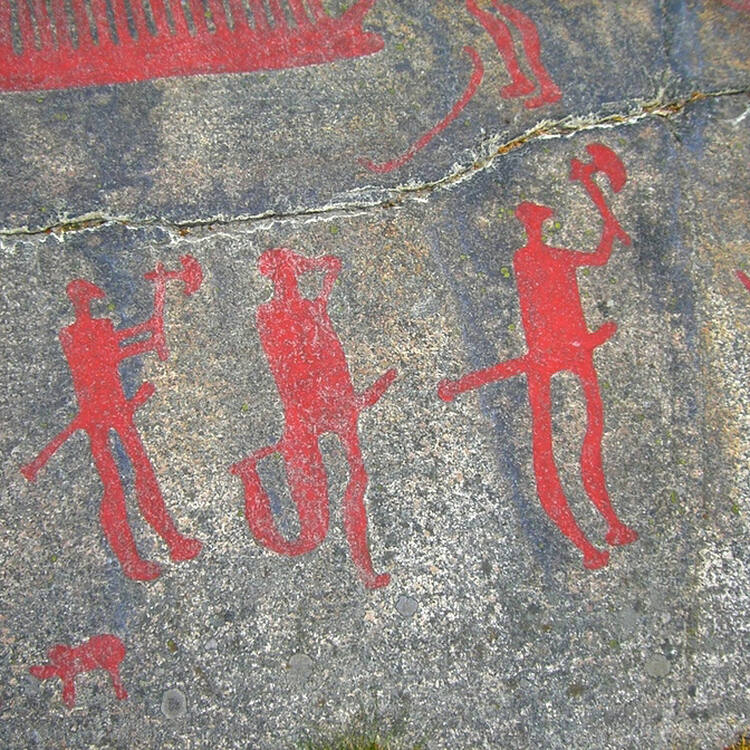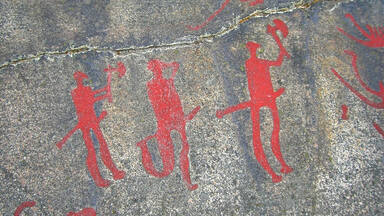Rock Carvings in Tanum
Rock Carvings in Tanum
The rock carvings in Tanum, in the north of Bohuslän, are a unique artistic achievement not only for their rich and varied motifs (depictions of humans and animals, weapons, boats and other subjects) but also for their cultural and chronological unity. They reveal the life and beliefs of people in Europe during the Bronze Age and are remarkable for their large numbers and outstanding quality.
Description is available under license CC-BY-SA IGO 3.0
Gravures rupestres de Tanum
Dans le nord du Bohuslän, les gravures rupestres de la commune de Tanum constituent un ensemble de toute première importance sur le plan mondial, tant par leur variété (représentations humaines et animales, armes, bateaux et autres objets) que par leur unité culturelle et chronologique. Elles illustrent, avec une abondance et une qualité remarquables, la vie et les croyances de l'âge du bronze en Europe.
Description is available under license CC-BY-SA IGO 3.0
النقوش الصخرية في تانوم
تقع هذه النقوش الصخرية في منطقة تانوم شمال محافظة بوهوسلان وتشكل النموذج الأكثر أهمية في العالم بفضل تنوع مواضيعها (من رسوم لبشر وحيوانات وأسلحة وسفن واغراض اخرى) والوحدة الثقافية والزمنية التي تمثلها. كما انها تجسّد بوفرة وقيمة كبيرتين الحياة والمعتقدات التي سادت في العصر البرونزي في اوروبا.
source: UNESCO/CPE
Description is available under license CC-BY-SA IGO 3.0
塔努姆的岩刻画
塔努姆的岩刻画位于瑞典哥德堡以北,它丰富多彩的图形(描绘人类和动物、武器、船只和其他物品),表现了它独一无二的艺术成就和文化与年代的统一。它丰富突出的作品反映了欧洲青铜器时代人们的生活和信仰。
source: UNESCO/CPE
Description is available under license CC-BY-SA IGO 3.0
Наскальные рельефы в Тануме
Наскальные рельефы в Тануме на севере Бохуслена – это художественный шедевр, уникальный не только благодаря разнообразию сюжетов (изображения людей и животных, оружия, лодок и др.), но также из-за их культурной и хронологической целостности. Петроглифы отражают жизнь и верования людей бронзового века в Европе, и замечательны своим большим количеством и выдающимся качеством.
source: UNESCO/CPE
Description is available under license CC-BY-SA IGO 3.0
Grabados rupestres de Tanum
Situada al norte de la región de Bohuslän, la localidad de Tanum posee un conjunto de petroglifos de importancia excepcional tanto por su variedad –representaciones de seres humanos, animales, armas, embarcaciones y objetos diversos– como por su unidad cultural y cronológica. Estos grabados rupestres, que son ilustrativos de la vida y las creencias de los pueblos europeos en la Edad de Bronce, destacan por su abundancia y la calidad de su factura.
source: UNESCO/CPE
Description is available under license CC-BY-SA IGO 3.0
タヌムの線刻画群
ノルウェーとの国境近く、オスロ湾に面した町ストレムスタートに残された岩壁彫刻、BC1000~BC500年ごろの青銅器時代のものとされる。数、種類とも豊富で、人間のほか、シカ、イヌ、ウマなどの動物、武器や船などが描かれ、先史時代のヨーロッパの人々の生活や信仰を知るうえで大切な手がかりとなっている。source: NFUAJ
Rotstekeningen in Tanum
De rotstekeningen in Tanum bevinden zich in het noorden van Bohuslän. Dit landschap bestaat uit granietgesteente, waarvan delen werden schoon geschraapt toen de ijskap langzaam naar het noorden bewoog. Hierdoor werden licht gebogen rotswanden blootgesteld. De tekeningen op deze rotsen zijn een unieke artistieke prestatie en opmerkelijk vanwege hun grote aantallen en uitstekende kwaliteit. Ze hebben niet alleen rijke en gevarieerde afbeeldingen (mensen, dieren, wapens, boten en andere voorwerpen), maar tonen ook culturele en chronologische eenheid. Ze onthullen het leven en de overtuigingen van Europese mensen in de Bronstijd. De levendige scènes en complexe composities illustreren het alledaagse leven, oorlogsvoering, cultus en religie.
Source: unesco.nl
Outstanding Universal Value
Brief Synthesis
The Rock Carvings in Tanum, located in the northern part of Bohuslän province in western Sweden (Västra Götaland County), are a unique artistic achievement for their rich and varied motifs (depictions of humans and animals, weapons, boats, and other symbols) and for the cultural and chronological unity they express. They reveal the life and beliefs of people living in the Nordic region of Bronze Age Europe, and are remarkable for their large numbers and outstanding quality. A cultural landscape with a continuity in settlement and consistency in land use that spans more than eight millennia, the area is rendered outstanding by its assemblage of Bronze Age rock art.
Northern Bohuslän is a land of granite bedrock, parts of which were scraped clean about 14,000 years ago as the Scandinavian Ice Sheet slowly moved northward, leaving gently curved rock faces exposed. These were the “canvases” selected by Bronze Age artists. There are at least 1,500 known rock carving sites in northern Bohuslän concentrated in certain areas, including the parish of Tanum. The carvings were executed by pecking and grinding the rock using stone hammers and points. The panels of rock art, skilfully created with simple tools, show a rich diversity of compositions of the highest quality, even when regarded simply as works of art or design. Compared to other similar contexts, these motifs and scenes are even more outstanding in their ability to convey reflections of life and cosmology during the Nordic Bronze Age (c. 1700 BC – 500 BC). It is obvious that the intention of these panels, which are often situated in commanding positions in the landscape, is to convey messages, thereby confirming their role as primary contemporary centres for worship and cult.
The Rock Carvings in Tanum represent a unique artistic achievement through their skilful and detailed depictions of animals, humans, ships, weapons, and symbols of the Bronze Age. These sometimes include lively scenes and complex compositions of elaborate motifs from travel, status, power, warfare, and cult. Some panels, or rather parts of them, were obviously planned in advance. Probably the most evident example of this is the panel at Fossum. In many cases, these motifs, techniques, and compositions create an exceptional testimony to the culture of the European Bronze Age.
Criterion (i): The rock carvings of the Tanum region constitute an outstanding example of Bronze Age art of the highest quality.
Criterion (iii): The range of motifs on the Tanum rock carvings provides exceptional evidence of many aspects of life in the European Bronze Age.
Criterion (iv): The continuity of settlement and the ongoing practice of agriculture, as illustrated by the Tanum region’s rock carvings, archaeological vestiges, and modern landscape features, combine to demonstrate a remarkable permanence during eight thousand years of human history.
Integrity
Within the boundaries of the 4,137.609 ha property are located all the elements necessary to express the Outstanding Universal Value of Rock Carvings in Tanum, including over 600 known rock carving sites, which is the highest density of such panels in northern Europe. The integrity and completeness of this area is illustrated in the centrally situated Tanum plain, where rock carving sites occur in zones in the plain’s western and north-eastern peripheries. The great majority of known settlements and prehistoric cemeteries are located at the northern and eastern edges of this plain. The boundaries thus adequately ensure the complete representation of the features and processes that convey the property’s significance. No buffer zone has been defined.
The property in general does not suffer from adverse effects of development and/or neglect. A significant proportion of the carvings are well preserved, although a few vulnerable sites are in the process of ongoing degradation. An upgrading of the E6 highway, which crosses parts of this property, was planned at the time of its inscription. Swedish authorities worked jointly with the World Heritage Centre and ICOMOS and reached a satisfactory solution in 2009 to protect the attributes that sustain the Outstanding Universal Value of the property. Eleven wind turbines located about 5 km northeast of the World Heritage property were approved according to Swedish legislation and completed in 2014. Studies indicate that the impact on the Outstanding Universal Value of the property is negligible. One wind farm approximately 10 km north of the World Heritage property is planned.
Authenticity
Rock Carvings in Tanum is entirely authentic in location and setting, forms and designs, materials and substances, and spirit and feeling, as substantiated by scientific studies of the carvings themselves and by comparative typological studies of dated Bronze Age art on other archaeological artefacts. The authenticity is expressed not only in the panels themselves, but also in the adjacent terrain, which may contain evidence of rituals and other practices connected to them. This authenticity has been maintained. The consistency in land use with its ongoing practice of agriculture makes it possible to understand the location of the panels close to the Bronze Age sea level. This also reinforces the authenticity of the property. In Tanum, as in the rest of Scandinavia, figures at selected rock carving sites have been repeatedly painted over the past five or six decades, since their granitic environment can make them difficult to distinguish. Today, only a few carefully selected exposed panels are painted with a non-destructive paint by trained specialists. Future structural changes in farming and agriculture may threaten the qualities of the open cultivated landscape.
Protection and management requirements
Rock Carvings in Tanum is designated as an Area of National Interest, and as such is protected under the Environmental Code (2010) and the Planning and Building Act (1987). A major part of this property includes about 1,000 individual monuments or groups of monuments that are protected under the Cultural Heritage Act (1998). All the rock carvings in the property are located on privately owned land except for part of those on Vitlycke Farm, which are owned by the Museum of Rock Carvings at Vitlycke. In 2012 the Management Council adopted a management plan that includes a vision and objectives for protecting and managing the property. The plan has a yearly revised plan of action focusing on organization, increased engagement of the local population, monitoring, sustainable tourism, and a full documentation of all panels (due to be finished in 2020). Three international research and development projects as well as comprehensive programs for recording damage have created vital basic knowledge for the implementation of future protection programs.
Sustaining the Outstanding Universal Value of the property over time will require ensuring the municipal master plan: continues to address wind energy issues, including impeding wind turbines within the World Heritage property; continues to identify areas outside the property with respect to the cultural and natural values of the landscape as a whole; and continues to examine the question of how increased sustainable tourism may contribute to the economic development of the region. Important steps in the latter include the creation of a rest stop in conjunction with the new E6 highway, as a gateway to the World Heritage property and with information about the area, and an increase in the visitor capacity of Vitlycke Museum. The museum, including the re-creation of a Bronze Age farm, plays an important role in helping visitors to decipher the rock carvings and the landscape. Its capacity as a visitor and management centre will be strengthened in coming years. The vulnerable sites in the process of ongoing degradation should continue to be closely monitored, and any degradation counteracted according to accepted international practices.
Heritage in Progress Conference (HIP) to be held in Gothenburg


